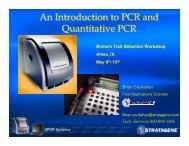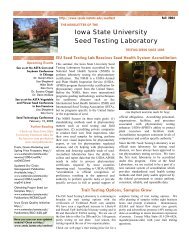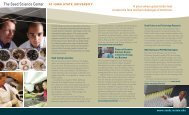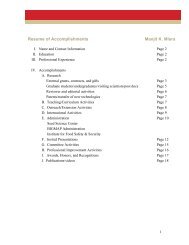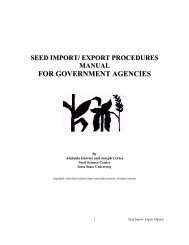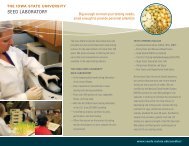Confined Production Processes for Non-Food Corn - Seed Science ...
Confined Production Processes for Non-Food Corn - Seed Science ...
Confined Production Processes for Non-Food Corn - Seed Science ...
You also want an ePaper? Increase the reach of your titles
YUMPU automatically turns print PDFs into web optimized ePapers that Google loves.
PRINCIPAL DIFFERENCES BETWEEN NURSERY ANDFIELD PRODUCTION PROCEDURESThe procedures <strong>for</strong> larger scale field production and <strong>for</strong>nurseries are generally similar, but nurseries have somesignificant differences:• Nursery operations depend more heavily on teams toplant, pollinate, and harvest.• Procedures give more attention to pollen control.• Outcrossing during hand pollination is rare.• Procedures give less attention to roguing.• Planting is nearly always in rows and ranges. Fieldproduction is less likely to be in rows and ranges.• Rows of 2-5 m in length are described by range androw coordinates.• Record keeping is required <strong>for</strong> each row.• Planting is complex and prone to error. Plantingerrors can result in misidentification of rows.• For some smaller nurseries, mechanical proceduresbecome optional, and it may be easier to per<strong>for</strong>mprocedures by hand than to clean the equipmentbe<strong>for</strong>e and after use.• Some events are eliminated be<strong>for</strong>e flowering.• The entire nursery is unlikely to be cancelled inmid-season, whereas a failed production field couldbe canceled in mid-season.• Pollen inflow is less of a consideration because ofhand pollination.• Pollination is complex and prone to error.• Mixing of events is possible at pollination.• Labels on individual plants used in crosses can be lost.• Increases <strong>for</strong> one PMP event could be mixed with seed orpollen from another, resulting in incorrectly labeled seed.• Sometimes ears are harvested very early to speedplanting of the next cycle.• Not all ears are pollinated in the nursery. Many ears areopen pollinated. There is more relatively more dry matter<strong>for</strong> destruction in relation to the grain harvested.• Errors in labeling are possible at harvest.• <strong>Seed</strong> processing is all in batch mode with easilycleaned equipment.• Errors in labeling are possible during processing.• The number of items in inventory can be very large.The reliance on teams opens the door to discussion ofquality and teamwork in management that goes beyondthe scope of this document. In practice, the relationship ofthe researcher as manager with a team has a significantimpact on errors and error rates.SUMMARYPMP and PMI nurseries and research inventory systemsare subject to both the possibility of misidentification ofevents and lines and to the possibility of genetic outflowof pollen, seed, and plant material. The unique aspect ofresearch nurseries is that they may contain a number ofevents, and these events can be associated with varyingdegrees of hazard.Conventional corn research nurseries are managed withprocedures that minimize the chance of error in theidentification of lines. When used <strong>for</strong> PMPs and PMIs,these procedures provide redundant systems <strong>for</strong> identificationthat allow the detection and correction of errors whenthey occur. Event-specific checks allow <strong>for</strong> the specificidentification of events in lines, especially when they arereleased from research nurseries to be used in foundationand field production. Event-specific tests also can beconducted to confirm that undesired genes are not present.The procedures <strong>for</strong> the prevention of outflows ofgermplasm and materials <strong>for</strong> nurseries are much the sameas <strong>for</strong> sterile field production. It seems prudent to classifythe risk that nurseries pose based on the hazard associatedwith the event with the highest LD50. Nurseries containinghazardous events likely pose greater concern than fieldproduction of less hazardous events, even when the areaof the field production is much larger.Nurseries containing hazardous events have a componentof risk that is associated with the number of tasks that areper<strong>for</strong>med in them. A research nursery may require tensof thousands of hand pollinations, and each has somepossibility of error. The work may involve dozens oftechnicians, so the frequency of human error is a concern.Field production procedures, especially those using sterilefemales and nontransgenic males, are inherently simpler.Where PMP or PMI nurseries are associated with greaterpotential risk due to uncertainties as to the nature of theexpressed product, isolation from nurseries with unregulatedcorn and from foundation seed stocks of unregulated corncan be an especially important consideration.



